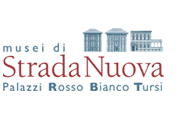The Textile Collections of the Museums of Strada Nuova came into being at the end of the 19th century, especially thanks to a series of donations by privates, which also continued in the next century and still do, thus continuously enriching this important collection.
One of the most conspicuous sections is clothing, documenting the evolution of men’s and women’s fashion across the 18th-20th centuries. One of the most significant groups is the series of 123 dresses, primarily men’s, dating between the 18th and 19th centuries, that the Genoese Giuseppe Zerega donated to the Municipality in 1917.
Alongside the beautiful, richly embroidered 18th-century garments, it is worth mentioning the luxurious gala costumes from the Napoleonic era, while the different stages of fashion in the 19th and 20th centuries are well represented by a large number of refined pieces in very good condition, including some wedding dresses and many evening gowns.
Fans, shoes, bags, hats, umbrellas and many shawls, including several Kashmir shawls, also enrich this section.
There are numerous pieces from the Eastern world, including a significant number of costumes dating from the 18th and 19th centuries, produced during the Ottoman rule, which has recently been accompanied by a number of dresses from various Middle Eastern countries, such as Afghanistan, Palestine, and Syria.
Equally important is the collection of laces, including pieces of the highest quality, produced by Italian or European manufacturers between the 16th-19th centuries: a magnificent 17th-century set of collar and cuffs in Genoese bobbin lace, purchased in 1922; Venetian needle laces; a series of light 18th-century French Argentan and Alençon laces; a group of marvellous Brussels laces from the 19th century.
As for textiles for liturgical or domestic use, Renaissance artefacts stand out, including a finely embroidered frontal and a 15th-century velvet cloth, as well as canopies, drapes and other pieces dating back to the 17th-18th centuries and made of sumptuous patterned or embroidered silk.
Of great interest is the collection of printed fabrics, consisting mostly of countless mezzari, large cloths with beautiful polychrome designs of Eastern influence, that Genoese ladies wore pinned on their head.
Closely linked to this type of artefacts is the series of wooden stencils for textile printing, important evidence of an ancient technique which spread in Genoa from the late-18th century. The Textile Collections, also featuring a number of tools for the processing of fabrics, such as several sewing machines and a pillow for the production of bobbin laces, have been recently enriched with an additional section on illustrated fashion magazines from the 18th to the early-20th century.
Since 2005, the rooms of the first mezzanine floor of the Palazzo Bianco house a section dedicated to the Civic Textile Collections, comprising about 1,800 pieces, including an important collection of men’s and women’s clothing and fashion accessories dating from the 18th-20th centuries, a series of lace pieces and many other precious textile products of different kinds and origins.
The rooms dedicated to textiles are divided into two areas: an exhibition area, showcasing rotating collections of artefacts, and a modernly equipped depository for consultation.
The rooms house temporary exhibitions on important issues of the history of fabrics and fashion fitted within the normal tour of the Museums of Strada Nuova. It is also possible to view the pieces of the Textile Collection not on display for the public, by contacting the curator of the collections and fixing an appointment in advance:




